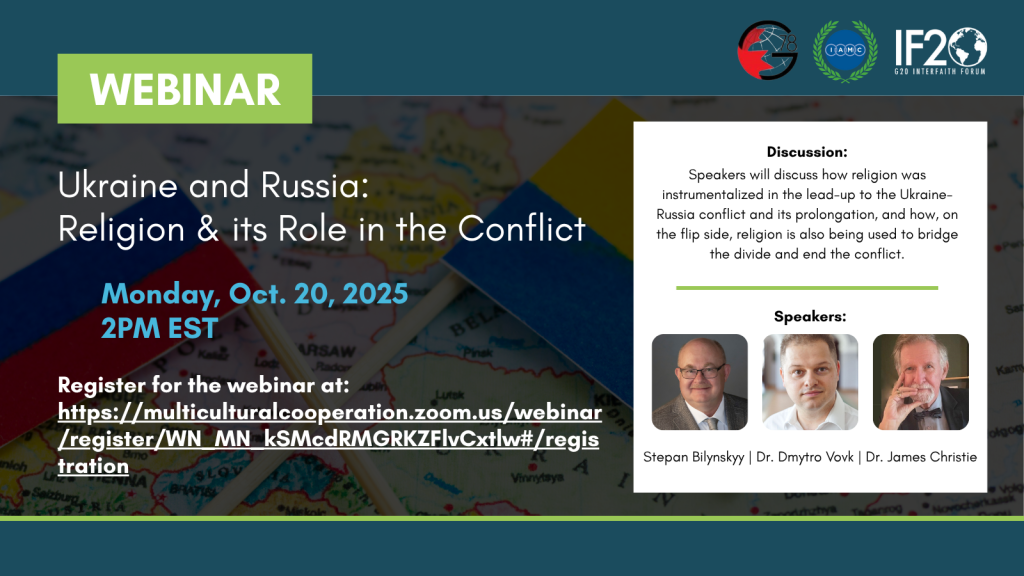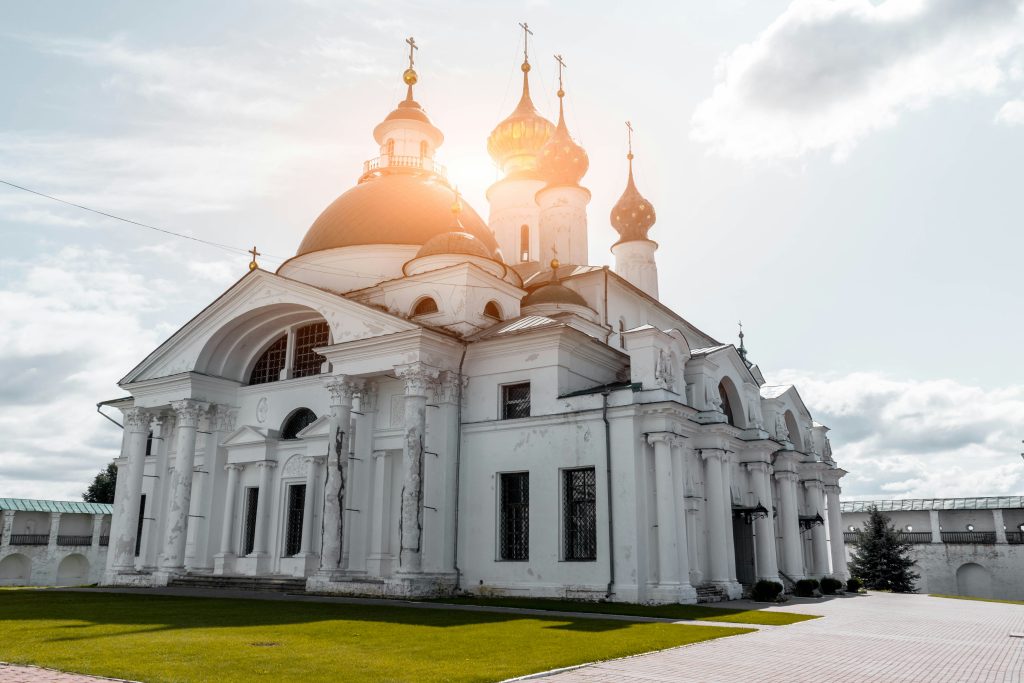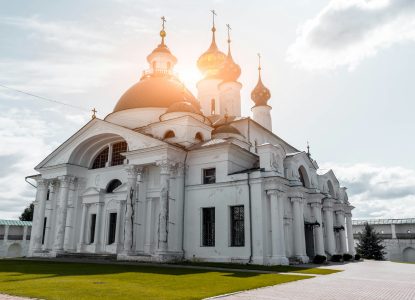By JoAnne Wadsworth, Communications Consultant, G20 Interfaith Forum
– – –
On October 20, 2025, the G20 Interfaith Forum’s Anti-Racism Initiative, in partnership with the Group of 78 and the International Academy for Multicultural Cooperation, held a webinar entitled “Ukraine and Russia: Religion and its Role in the Conflict.”
Speakers included Dr. Stepan Bilynskyy, MD, MA, Spiritual Health Practitioner at Grace Hospital (Winnipeg Regional Health Authority), Permanent Deacon, and Co-leader of Manitoba Jewish-Catholic Dialogue; and Dr. Dmytro Vovk, Director of the Center for Rule of Law and Religion Studies at Yaroslav Mudryi National Law University in Ukraine and Visiting Professor at Benjamin N. Cardozo School of Law. Dr. James Christie, Reverend and Professor Emeritus of Theology at the University of Winnipeg, moderated the discussion.

In his opening remarks, Dr. Christie framed the webinar as part of an ongoing series examining what he called “the first war on the European continent since the end of the Second World War in 1945.” Both Ukraine and Russia have used religion as a rallying call to increase the legitimacy of their agendas—an approach that has proven quite successful. Yet there are also religious actors working to bridge the divide and help end the conflict.
Dr. Stepan Bilynskyy
Dr. Bilynskyy opened with historical context, displaying a 1918 map showing how Ukrainian territories have shrunk significantly over time, absorbed into Russian and neighboring territories. In contrast, Russia has expanded continuously since the 1300s, at one point even including Alaska. He cited President Putin’s recent statement that “where the foot of a Russian soldier sets, it’s ours”—a claim extending not just to Ukraine but to former Russian territories worldwide.
“Today, these religious themes are often interpreted through the lens of old imperialistic theories such as pan-Slavism, the Third Rome concept, and Russkiy Mir. Recognizing the distinct identities of both nations as separate entities is crucial in countering propagandist agendas and fostering a foundation for meaningful dialogue.”
Bilynskyy then showed images of the “dragon ramparts” (Zmiiovi Valy)—ancient defensive structures near Kyiv erected between the 2nd century BC and 7th century AD. During Russia’s 2022 invasion, these structures actually stopped advancing Russian tanks.
“So basically … our land itself was fighting with the invaders. We have a deep attachment to the land.”
He recounted witnessing his first religious confrontation in 1989 in Ivano-Frankivsk, when communities divided violently between the traditional Ukrainian Orthodox Church and the Russian Moscow Patriarchate church, requiring military intervention. These conflicts continue today—Bilynskyy showed a June 2025 photograph from Chernivtsi depicting confrontation between believers over a planned service in Ukrainian language.
Bilynskyy highlighted a striking asymmetry: over 8,000 churches run by the Moscow Patriarchate operate in Ukraine, while in Russia there is only one Ukrainian Catholic Church—despite 5.8 million people identifying as Ukrainian in the Russian Federation.
He discussed doctrines still influencing the conflict, including the 16th-century “Third Rome Doctrine” and “Russkiy Mir” (Russian World)—a political and religious doctrine that many Orthodox churches consider heretical. He then showed historical evidence of the Moscow Patriarchate’s resurrection by Joseph Stalin in 1923, including an image of women carrying an icon depicting Stalin as a holy man.
Dr. Dmytro Vovk
Dr. Vovk approached the topic from a legal perspective, focusing on developments since 2014.
“I think it’s quite clear that the Russia-Ukraine war is not a religious war in the sense that there are certain religious goals of this war. Rather, both parties with very different dynamics used religion to pursue certain political goals.”
Following Crimea’s 2014 annexation, Putin compared it to Temple Mount for Russians. This intensified before the 2022 invasion. In July 2021, Putin published an article claiming religious unity justified his conclusion that Russians and Ukrainians are one people. Days before the invasion, he accused Ukraine of preparing to shut down the Ukrainian Orthodox Church affiliated with the Moscow Patriarchate.
The Russian Orthodox Church has extensively supported Putin, Vovk explained. Patriarch Kirill repeatedly justified the war, “claiming even that the Russian soldiers who would die on the battlefield in Ukraine would have their sins washed away.”
The church’s support extends beyond theology. Russian priests are involved in propaganda, NGOs affiliated with the church provide weaponry to the military, and the church promotes Russia’s narrative at international forums. Most disturbingly, Vovk presented evidence that clerics are involved in re-educating deported Ukrainian children—potentially war crimes. Children placed in church-run shelters were baptized into the Russian church and encouraged to join military-patriotic youth organizations.

In Ukraine, President Zelensky initially maintained religious neutrality but by late 2022 proposed a law adopted in August 2024 aiming “to liberate Ukrainian Orthodoxy from Moscow devils.” The law recognizes the Russian Orthodox Church as part of the Russian state and partner in war crimes, establishing mechanisms to ban Ukrainian communities affiliated with the Russian church—even based solely on ecclesiastical connections.
From an international law perspective, this raises concerns. Religious freedom cannot be limited based solely on ecclesiastical connections. International standards advise that religious organizations can be banned only if leadership or the majority of members are involved in illegal behavior. With 10,000 clerics and only about 40 criminal convictions, proving widespread illegal activity is difficult. Denial of legal personality should be a last resort.
“Putin started this war claiming that Russians and Ukrainians are the same people, and the Russian Orthodox Church supported and endorsed the war, claiming that the Russian world includes Ukraine. Ironically enough, this has accelerated nation-building processes in post-Soviet space, with the goal to erase any links with Russia, even at the cost of personal freedom.”
Discussion and Moving Forward
During the discussion, Bilynskyy noted that some Russian Orthodox Church clerics outside Russia have tried supporting Ukraine but faced excommunication or exile. Vovk acknowledged oppositional voices exist, but noted the Russian Orthodox Church appears institutionally consolidated around supporting Putin, reflecting broader Russian society.
Regarding Ukraine’s competing churches, Vovk made a surprising observation:
“While I understand that for Orthodox people, it might be a tragedy that the church is split and there are two or three competing churches in the region, scientifically speaking, it’s probably the best thing that happened with religious freedom in Ukraine.”
The competition prevents either church from becoming too close to the state. Since independence, Ukraine has been a religious freedom champion in the region, with the biggest Baptist community in Europe and the largest Latter-day Saints community in post-Soviet space.
When asked whether religious influence could help end the conflict, Bilynskyy emphasized that “Dialogue cannot be provided with a strong agenda. Dialogue can actually exist only when you have mutual listening and a willingness to be transformed by this conversation.”
Dr. Christie closed with a quote from theologian Reinhold Niebuhr:
“Nothing worth doing can be achieved in a lifetime. Therefore, we must be saved by hope… Nothing that is true or beautiful or good makes complete sense in any immediate context of history. Therefore, we must be saved by faith… And nothing that we do, however virtuous, can be accomplished alone. Therefore, we are saved by love.”
The webinar revealed the profound complexity of religion’s role in the conflict—as both a weapon and a potential bridge, a tool for control and a source of freedom.
– – –
JoAnne Wadsworth is a Communications Consultant for the G20 Interfaith Association and acting editor of the “Viewpoints” blog.


